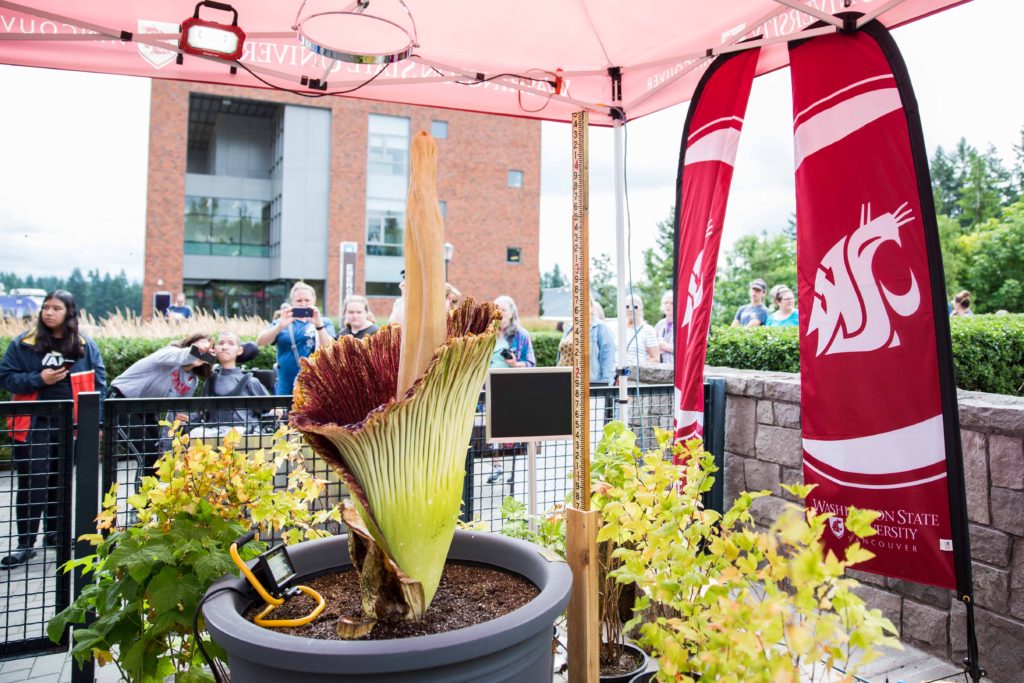On-site interviews courtesy of Krysten Stewart & Brody Voge
The corpse flower [Amorphophallus titanum] — named Titan VanCoug — bloomed for the first time since it was planted 17 years ago. Both flies and spectators are abuzz at WSU Vancouver to catch a glimpse of the putrid smelling flower.
Professor of molecular bioscience Steve Sylvester, requested the Titan Arum seed in 2001 believing, once cultivated, would be a good way to bring people to campus.

He said he dreamed people would enjoy experiencing the bloom, while also bringing recognition and contributing to the research-focused identity of WSU Vancouver. What began as a seedling on his desk, is now on display outside of the Science and Engineering Building for all to view.
The blooming of a corpse flower is rare, taking anywhere from seven to ten years in the wild. Sylvester explained, the corpse flower is native to the rainforests of Sumatra and needed heat and plenty of room to bloom.
Sylvester said, “I really enjoy the response of people in seeing it and [also] in all the people on campus that have invested hope and admiration of the plant for years.”
He said his first reaction to Titan VanCoug’s blooming was, “ … a panic, and then don’t drive too fast on the freeway, and then, oh my gosh.” Despite the long night, Sylvester said, “I’m not tired at all. I’ve been waiting 17 years.”
He explained that for pollination, the blooming corpse flower releases a putrid perfume to attract flies, dung beetles and other flesh-eating insects. This smell, along with it’s fleshy red color is why it is called a corpse flower.

Students, staff and community members visit the WSU Vancouver campus to witness the long-awaited bloom of Titan VanCoug, a rare corpse flower.
(Sydnie Kobza/The VanCougar Newsmagazine)
“It smells like rotten meat to me,” Julia Getchell, director of human resources, said. “This is the first time this plant has bloomed in this region … We’ve been anticipating this moment for a very long time.”
Getchell explained, Titan VanCoug and it’s mother, “Big Bucky,” — homed at the University of Wisconsin — both bloomed in the middle of the night, close to a full moon.
Because it was difficult to determine when exactly the corpse flower would bloom, Sylvester had 24-hour surveillance on the plant and measured it daily. He said the attention and time required in cultivating a Titan Arum are the most difficult parts.
“I’ve done everything wrong, but I’m very lucky.”
-Steve Sylverster
The campus anticipated 20,000 visitors due to the campus’ close proximity to Portland, according to Sylvester.
To assist with visitors, Sylvester, university staff and students remained close by to answer questions about the plant and the university. Students manned tables and booths to inform the many visitors of other research projects being conducted on campus.

Andrew Nevue, a senior digital technology and culture major and student ambassador, said, “It’s super exciting to see the community come together to see the bloom.”
Max Ault, assistant vice chancellor for strategic partnerships, commented on the significance of the bloom to WSU Vancouver and the surrounding community. Ault said, “The blooming is special, but the opportunity to share that with our community that we’ve grown up in, together is huge … People start to think about what does it mean to be at WSU Vancouver, what research looks like, what education looks like, I think is hugely important.”
The display is open to the public. WSU Vancouver invites the community to view the plant. According to the news release, anyone can view the plant from 8 a.m. to 9 p.m. during weekdays.If unable to visit Titan in person, watch Titan VanCoug any time via webcam at https://www.youtube.com/wsuvancouver.

Krysten Stewart is a junior at WSU Vancouver pursuing an English degree.
